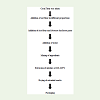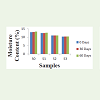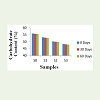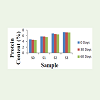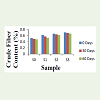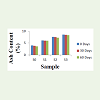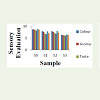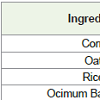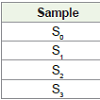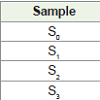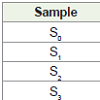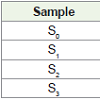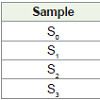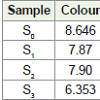Research Article
Development, Quality Evaluation and Shelf Life Studies of Extruded Herbal Snack Foods with Fortified Ocimum Basilicum
Mrudula G*, Suman M, Neelima T, Srinivas Maloo and Bhasker V
Department of Food Technology, Osmania University College of Technology, Osmania University, Hyderabad, Telangana-500007, India
Corresponding author: Mrudula Guggilla, Department of Food Technology, Osmania University College of Technology,Osmania University, Hyderabad, Telangana-500007, India; Tel: 9640905136; E-mail: mrudu286@gmail.com
Citation: Mrudula G, Suman M, Neelima T, Srinivas M, Bhasker V. Development, Quality Evaluation and Shelf Life Studies of Extruded Herbal Snack Foods with Fortified Ocimum Basilicum. Indian J Nutri. 2017; 4(4): 172.
Copyright © 2017 Mrudula G, et al. This is an open access article distributed under the Creative Commons Attribution License, which permits unrestricted use, distribution, and reproduction in any medium, provided the original work is properly cited.
Indian Journal of Nutrition | ISSN: 2395-2326 | Volume: 4, Issue: 4
Submission: 11/04/2017; Accepted: 19/09/2017; Published: 23/10/2017
Abstract
Extruded herbal snack was developed by using single screw extruder using corn flour, oat flour, and rice flour and Ocimum basilicum paste respectively. After a thorough study and several attempts made to develop this herbal snack with a different portion of ingredients and the shelf life of the product was conducted for about two months. Three different portions of corn flour, oat flour, rice flour and Ocimum basilicum paste were taken in the proportion of (60:20:15:5) for the first sample, (50:30:10:10) for second sample and (40:40:10:10) for the third product sample respectively. Physico-chemical and sensory analysis of the samples was conducted. During the storage of the product, it was observed that the moisture content of the products was increased slightly whereas the other parameters were found to be decreased with the storage time. Among the three samples, the one with 50% and 40% corn flour were found to be acceptable. Depending on the sensory attributes observed, the sample with 50% corn flour was found to be satisfactory during the storage period and is an adequate sample among the three. Therefore, the developed snack is fiber rich and of low calories. Also due to the addition of paste, Ocimum basilicum the prepared snack has the anti-inflammatory and anti-microbial properties and the Ocimum basilicum paste is one of the finest sources of many essential nutrients, minerals and vitamins that are required for the optimum health.
Keywords:
Extruded herbal snack; Oat flour; Ocimum basilicum; Fiber rich; Low calories; Shelf life
Introduction
In the present world, the biggest challenge for the food industry is to develop the health promoting foods. The future of the food products ultimately regards how it affects the consumer health and the raw materials that will deliver such health benefits [1]. Meanwhile, traditional food patterns are being broken down. Today’s lifestyle of individuals is becoming more hectic and people have very less time in preparing meals, this eventually affecting the rise in interest towards snacking patterns [2]. Unfortunately, due to the high salt and fat contents in the snacks, people health is concerned more. The greater concern towards a healthier diet has led many food producers to look at the substitutive snack products that avoid high levels of fat, sugar, and salt and also which are fortified with vitamins and minerals. Even the ingredients/ raw materials are described as functional and snack products which have fruits or vegetables respectively [3].
Even in our history, it has been mentioned that the herbs have been added to foods either for preservation or flavour purposes. Use of different herbs in food products can make foods more acceptable, healthier and the addition of herbs leads to removal of salt and fat, as herbs are such useful flavoring agents [4]. Also, herbs contain more pharmacological properties [5]. As of the facts seen, herbs are useful flavoring agents for snacks and some of the herbs often have used to gain pharmacological activity to these products [6-8]. By the addition of herbs to the food products, the health benefits and flavour of the products can be improved.
Extrudates are microbiologically safe due to lower moisture content and requires less labour for handling and requires less packing material and storage space [9]. Extrusion cooking is High- Temperature Short Time (HTST) technology, and a continuous cooking, mixing and final production process with low cost of production and high efficiency [10-12]. During extrusion, the cooking temperature should be 180-190°C with 20-40 seconds of time respectively. During extrusion cooking, gelatinization of starch, protein denaturation, inactivation of raw food enzymes, decreasing the microbial load in the final product would occur. Food extrusion has quite distinct advantages like versatility, high productivity, low cost, a variety of sizes and shapes, final product quality and energy efficiency, new food production and no food wastage.
Developed extruded product will show excellent functional characteristics with improved health benefits due to the addition of Ocimum basilicum paste to corn. To improve nutritional value, physical state and to improve the functionality of the end product, the extrusion cooking was adopted.
Materials and Methods
The raw materials corn flour, oat flour, rice flour and Ocimum basilicum paste were procured from the local market of Hyderabad. The extruded herbal snack was developed, and quality analyses were conducted in Department of Food Technology, OUCT, Osmania University and Hyderabad. The experimental procedure and product formulation are shown in Figure 1-7 and Table 1.
Development of extruded herbal snack physico-chemical analysis
Crude fiber was analyzed by the method of A.O.A.C., 1999 [13]. Crude protein and total ash content were analyzed by using the method given by A.O.A.C., 1980. Determination of fat and moisture content was done by the standard method provided by A.O.A.C., 1999 [14]. With the help of Anthrone method, the carbohydrate content of the developed product was determined respectively.
Sensory evaluation was done by 9-point hedonic scale. Based on the six parameters (color, aroma, taste, flavour, texture and overall acceptability), the sensory quality of the developed product was determined respectively. The sensory evaluation was done by using a hedonic scale, with extremes of 1 (disliked extremely) and 9 (liked extremely) to analyze the product acceptability respectively.
Results and Discussions
Moisture content
The moisture content of the developed extruded herbal snack with different proportions of corn flour, oat flour, rice flour and Ocimum basilicum paste during the storage period of 2 months was determined with the standard method A.O.A.C., 1999. As shown in Table 2 the moisture content was high in sample S0(13.328%) followed by S1(12.674%) and sample S2(11.029%) and the least was observed in sample S3(10.401%) after 60 days of storage period. The lesser moisture content in sample S3 may be attributed due to the presence of more oat flour than other samples respectively. As of the fact, oats contain more fiber content, so less the moisture content respectively [15,16].
The moisture content decreases considerably in different samples from S0 to S3. During the storage period of 60 days, it was observed that there was a significant increase in moisture content. When we observe, the sample S2 was found to be having a slight increase in the moisture content compare to that of other samples, which makes it more acceptable.
Carbohydrate content
During the storage period of 60 days, the change in carbohydrate content of the extruded herbal snack containing corn flour, oat flour, rice flour and Ocimum basilicum paste has been evaluated and is presented in Table 3. From the data, it was clearly seen that there was a slight decrease in carbohydrate content of samples prepared. Due to the high incorporation of corn flour in sample S0, the carbohydrate content was observed to be greater than other samples. The difference in carbohydrate content in different samples was may be due to the presence of a different proportion of corn flour in the developed samples. Similar results were found in the research conducted by Sumathi et al., [17]. With the increase in shelf life of the samples from 0 to 60 days, the significant decrease in carbohydrate content was observed respectively.
Protein content
The protein content of the samples S0, S1, S2, and S3 was determined by the standard analysis method given by A.O.A.C., 1980 [13]. The results obtained clearly indicated that there was a slight decrease in protein content of samples. From the Table 4, it is observed that the protein content of the sample S3 is higher than other samples. The protein content increased considerably in different samples due to different portions of corn flour, oat flour, rice flour and Ocimum basilicum paste respectively. A significant decrease of protein content was observed in the four samples during a storage period of 60 days.
Crude fiber
From the results obtained, it is clearly observed the changes in crude fiber content in four samples. It is tested for 30 days of interval. The increase in crude fiber content in the four samples may be due to the addition of increased amount of oat flour in each sample respectively. From Table 5 it is observed that there is a decrease in each sample crude fiber content during the storage period of 60 days respectively. Similar results were seen in the research study conducted by Deepika et al.
Ash content
As observed in Table 6, the ash content of the developed extruded herbal snack samples is increased. This increase in as content may be due to the addition of oat flour and Ocimum basilicum paste in different proportions to each sample. When we observe the results, it is clear that, along with the storage period of 60 days, the ash content is decreased considerably.
Sensory evaluation
During the storage period of 60 days of samples S0, S1, S2, S3 it is observed that the sensory attributes of the samples were slightly decreased respectively. From the Table 7, the sample S2 has more palatability, i.e., the acceptability of this sample was a way more acceptable than other samples.
Conclusion
Thus from this present research study and results obtained it can be concluded that a high quality extruded herbal snack can be made out by incorporating different proportions of corn flour, oat flour, rice flour and Ocimum basilicum paste. But among all the samples, the sample with the formulation of sample S2 was considered to be more acceptable. The shelf life analysis of the extruded herbal snack was conducted for two months at an interval of 30 days respectively.
References
- Heasman M, Mellentin J (2014) The functional foods revolution: Healthy people, health profits. Earthscan Publications, London. pp: 334.
- Pomar international (1997) Snack foods, part 1: The snack food market. Food ingredients and analysis international. pp. 19-22.
- Tuley L (2000) Snacks go healthy. Food manufacture. pp. 30-31.
- Dole Food Company (2002) Encyclopedia of foods: A guide to healthy nutrition. San Diego, USA. pp: 516.
- Thomas SC (2000) Medicinal plants: Culture, utilization and phytopharmacology. CRC press, New York. pp. 536.
- Williams D (1999) Flavors for snack- Food applications. Perfumer & Flavorist 24: 29-34.
- Nordmark B (1999) Snack flavors revolution. Food technology in New Zealand 34: 26-27.
- Pszczola DE (1999) Ingredients: Nutraceuticals that take the form of candy and snacks. Br Food Technol 53: 74- 80.
- Filli KB, Nkama I (2007) Hydration properties of extruded fura from millet and legumes. Food J 109: 68-80.
- Ryu GH, Neumann PE, Walker CE (1993) Effects of some baking ingredients on physical and structural properties of wheat flour extrudates. Cereal Chem 70: 291-297.
- Abd El- Hady EA, Mostafa GA, El-Samahy SK, El-Saies IA (1998) Production of high fiber corn extrudates. J Agric Sci 23: 1231-1245.
- Ding Q, Ainsworth P, Tucker G, Marson H (2005) The effect of extrusion conditions on the physicochemical properties and sensory characteristics of rice- based expanded snacks. J Food Eng 66: 283-289.
- AOAC (1999) Official method of analysis, 16th Edition. Association of official analytical chemists. pp. 440-446.
- Akhtar S, Anjum FM, Rehman SU, Sheikh MA, Farzena K (2008) Effect of fortication on the physico-chemical and microbiological stability of whole wheat flour. Food Chem 110: 113-119.
- Elleuch M, Bedigian D, Roiseux O, Besbes S, Blecker C, et al. (2011) Dietary fiber and fiber- rich by- products of food processing: Characterization, technological functionality and commercial applications. Rev Food Chem 124: 411- 421.
- Sumathi A, Ushakumari R, Malleshi G (2007) Physico-chemical characteristics, nutritional quality and shelf-life of pearl millet based extrusion cooked supplementary foods. Int J Food Sci Nutr 58: 350-362.
- Balfour D, Sonkar C, Sharma S (2014) Development and quality evaluation of extruded fortified corn snack. Int J Food Nutr Sci 3: 60-65.

